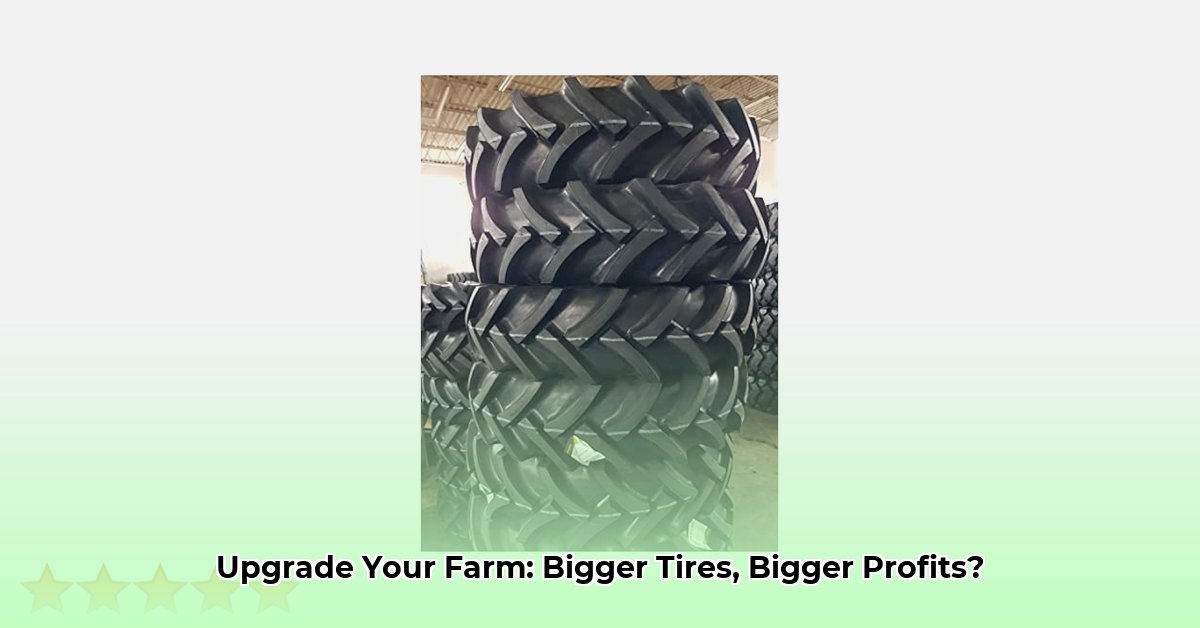
11.2 x 24 Tractor Tires: A Deep Dive into Sustainable Farming
Choosing the right tractor tires significantly impacts farm sustainability and profitability. The 11.2 x 24 tire, a popular choice among farmers, offers a compelling blend of performance and environmental responsibility. This article delves into its specifications, sustainability benefits, application guidance, and the future of sustainable tire technology.
Don't underestimate the impact of your tractor's tires on your farm's environmental footprint. Did you know that tire selection can directly influence soil health and fuel consumption? For more tire options, check out our other tire sizes.
Technical Specifications: Understanding the 11.2 x 24
The 11.2 x 24 designation refers to the tire's width (11.2 inches) and diameter (24 inches). While specific specifications vary by manufacturer, key features include:
- Dimensions: 11.2 inches wide, 24 inches in diameter. This size is compatible with many common tractor models.
- Load Capacity: This varies but is generally high enough for various agricultural implements. Always consult the manufacturer's specifications for the precise load capacity of the specific tire model you are considering.
- Ply Rating: Indicates tire strength and durability. A higher ply rating denotes a more robust tire, yet may result in a slightly harsher ride.
- Tread Pattern: The tread design affects traction, soil compaction, and fuel efficiency. Deep lug patterns provide superior grip, but might increase soil compaction compared to shallower tread designs.
These specifications are crucial for ensuring the tire is suitable for your tractor's weight and the application requirements.
Sustainability Advantages: Eco-Friendly Farming with 11.2 x 24 Tires
The 11.2 x 24 tire contributes positively to sustainable agricultural practices through several key features:
- Reduced Soil Compaction: Proper inflation is paramount. Under-inflation increases ground pressure, leading to soil compaction, while over-inflation can also cause problems. Finding the optimal inflation pressure for your soil type is crucial to minimizing compaction, which improves water infiltration, root growth, and overall soil health. This reduces the need for corrective measures and ultimately contributes to long-term soil fertility.
- Improved Fuel Efficiency: Lower rolling resistance translates to reduced fuel consumption per acre. Less fuel usage means lower operating costs and a smaller carbon footprint. This economic and environmental benefit is significant in the long term.
- Extended Tire Lifespan: Proper maintenance contributes to a longer tire lifespan, reducing the frequency of replacements. This decreases waste and lowers the demand for new tire production. Reduced replacement cycles directly translate to lower resource consumption and less landfill waste.
Selecting the Right Tire: A Practical Guide for Farmers
Selecting the ideal tire hinges upon several factors:
- Soil Type: Heavy clay soils benefit from deep-lug tires for increased traction, while lighter soils may perform better with shallower treads for reduced compaction.
- Terrain: Hilly or uneven terrain requires tires with deep treads and robust sidewalls for better stability. Flat fields may tolerate shallower treads to minimize soil disturbance.
- Crop Type: Heavier equipment and intensive farming operations necessitate higher load-capacity tires.
The following table provides a simplified guide:
| Soil Type | Terrain | Typical Crop | Tire Recommendation |
|---|---|---|---|
| Heavy Clay | Hilly/Rolling | Corn, Wheat | Deep lug, high-traction, strong sidewalls |
| Loam | Flat to Rolling | Soybeans, Alfalfa | Moderate lug, balance traction & compaction |
| Sandy | Flat | Vegetables, Fruit | Shallow lugs, low-compaction design |
Always consult with tire specialists for personalized recommendations based on your specific circumstances.
Tire Maintenance: Maximizing Lifespan and Sustainability
Proper tire maintenance is crucial for extending the lifespan of your 11.2 x 24 tires and minimizing environmental impact. Follow these steps:
- Regular Inflation Checks: Monitor tire pressure regularly using a reliable gauge, inflating to the manufacturer’s recommended PSI. Consistent pressure ensures optimal performance and reduces soil compaction.
- Tire Rotation: Rotate tires according to the manufacturer's guidelines to promote even wear and maximize lifespan.
- Careful Storage: Store tires correctly during the off-season to protect them from the elements and extend their useful life.
- Regular Inspections: Inspect tires frequently for cuts, punctures, and other damage. Addressing minor issues promptly prevents larger problems.
Emerging Trends in Sustainable Tire Technology
The future of sustainable agriculture includes advancements in tire technology. Expect to see:
- Bio-based Materials: Increasing use of renewable resources in tire manufacturing.
- Improved Tread Designs: Innovations focused on reducing soil compaction and enhancing fuel efficiency.
These developments promise even greater sustainability in farming. Staying informed about these advancements is crucial for optimizing your farming practices.
Conclusion: Driving Towards a Sustainable Future
The 11.2 x 24 tire represents a significant step towards sustainable agricultural practices. By understanding its specifications, employing best practices for selection and maintenance, and staying abreast of emerging technologies, farmers can significantly improve their farm's environmental impact and economic viability. It's an investment in both your productivity and the planet's health.